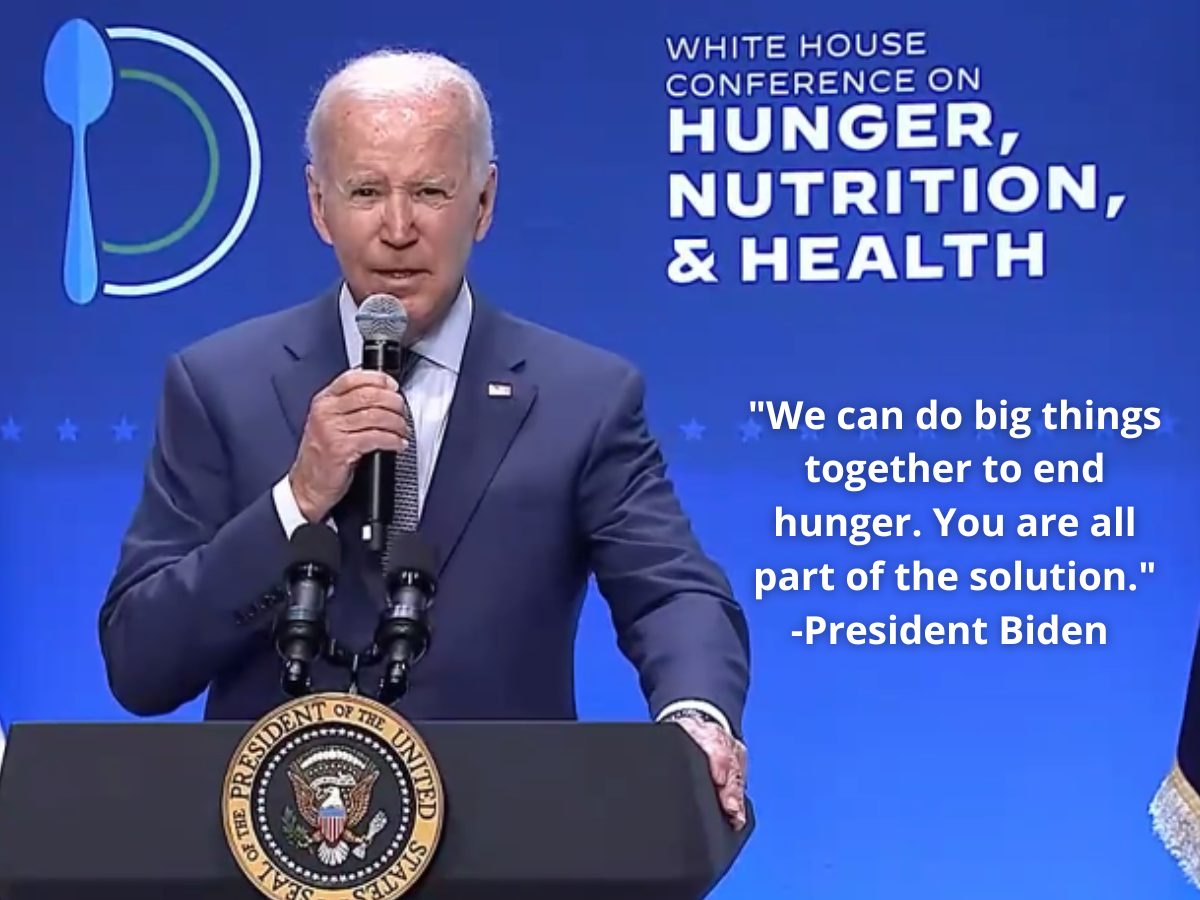Recap: White House Conference on Hunger, Nutrition and Health
October 10, 2022

On September 28 2022, for the first time in over 50 years, the Biden-Harris Administration hosted a White House Conference on Hunger, Nutrition, and Health. Lack of access to healthy, safe, and affordable food, and to safe outdoor spaces, contributes to impacting hunger, diet-related diseases, and health disparities. The COVID-19 pandemic has exacerbated these challenges further. The First White House Conference on Food, Nutrition, and Health had a significant influence on the country’s food policy agenda for half a century.
The Administration has set a goal of ending hunger and reducing diet-related disease by increasing healthy eating and physical activity in the U.S.by 2030. This ambitious goal would mean that no Americans go hungry and fewer Americans experience diet-related diseases like diabetes, obesity, and hypertension. At the Conference, the Administration announced a bold national strategy that outlines steps the federal government and other stakeholders will take to achieve this goal.
As part of our participation in this historic conference, NCA did the following:
- In June 2022, NCA invited over 100,000 members of the CACFP community for a partner-led convening to gather feedback for the White House ahead of the conference.
- We used the feedback to produce a white paper stating the problems and recommendations within the CACFP, and sent it along with a letter for consideration.
- We wrote a stakeholder commitment letter, committing NCA to numerous steps to help end hunger in the United States, particularly in support of the first pillar within the conference agenda.
- We held watch party and chat during the conference to view the lives stream and participate in the conference virtually.
- Our President & CEO, Lisa Mack, attended the conference in person to listen and advocate on behalf of the members of NCA and the CACFP Community
Conference sights and sounds
While attending the conference in Washington D.C., Lisa had the opportunity to engage with several national allies and advocates for the CACFP. Chief among these was Stacy Dean, Deputy Under Secretary for Food, Nutrition and Consumer Services at the Department of Agriculture. She shared the following message to the CACFP community:
“We are so grateful for everything you do, and everything you do is embodied in this conference. You change the lives of children, you change their futures, and we plan to leverage your expertise and spread the world to child care leaders across the country.”
Opening remarks were made by President Biden, and the conference itself included many panel sessions. Attendees heard from advocates such as Senator Corey Booker and Secretary Xavier Becerra. An inspiring and passionate address was given by Chef Jose Andres in which he reminded us that the most important source of energy in this country is the food that we eat.

Lisa Mack, President & CEO of National CACFP Sponsors Association and Congressman Jim McGovern, Chairman of the House Rules Committee

Lisa Mack, President & CEO of National CACFP Sponsors Association and Stacy Dean, Deputy Under Secretary for Food, Nutrition and Consumer Services at the Department of Agriculture
The CACFP in the National Strategy on Hunger, Nutrition and Health
In conjunction with the conference, the White House released a national strategy to accomplish the administration’s goal The CACFP is integrated in several priorities throughout the strategy and will play an important role in ending hunger.
The strategy is divided into several pillars of emphasis; however, most of the work of the CACFP belongs in Pillar 1: Improve Food Access and Affordability: End hunger by making it easier for everyone—including individuals in urban, suburban, rural, and Tribal communities, and territories—to access and afford food. Within that pillar, here are just a few points that directly or indirectly pertain to CACFP stakeholders.
Childcare
Pillar one of the national strategy has a lot to say about the intersection of child care and nutrition, and emphasizes the investment “in affordable, high-quality child care” as a critical priority. At the corner of high-quality childcare child nutrition, you’ll find CACFP operators. Closely examining the relationship between early education and physical health will inevitably include CACFP stakeholders in the conversation, and we’re prepared to meet the challenge.
Beyond that, “A “healthy meals for all” approach is specifically addressed in the national strategy. Healthy meals for all would reorient the school meal programs from an ancillary service at schools to an integral component of the school day and allow schools to focus on providing the highest quality meals and engaging children around healthy food. While this policy specifically addresses K-12 schools, it’s an indicator of a paradigm shift toward the role nutrition plays in education and development, and the effects of this mindset would certainly influence child nutrition programs in the child care setting.
Streamlining requirements
Further on, in Pillar 1A it states that “HHS ACF will also issue a model application and guide to help states develop improved applications and verification processes for child care subsidies and encourage collaboration between state child care agencies and state agencies administering food and nutrition programs. Such early care and education programs are an essential source of healthy meals and services that support the growth and wellbeing of young children”
While not specifically for CACFP, this model could serve as an example on how licensing could work with food programs to streamline requirements. Providers have indicated that challenging paperwork and application processes are a significant barrier to participation in the food program, and thoughtfully updating those processes would surely expand the program.
Later in the strategy, it’s added that “USDA will work to ensure that food served in the Child and Adult Care Food Program (CACFP) and the Summer Food Service Program (SFSP) aligns with the Dietary Guidelines for Americans wherever feasible.” Simplifying the meal pattern and ensuring that it is clearly aligned with evidence-based guidelines will help improve provider retention.
“Barriers to participation include the added administrative time for providers. They already serve food, but are overwhelmed by recordkeeping, enrollment and eligibility requirements, etc.” -CACFP Provider
Holistic approach
The CACFP is further implicated in calls for a holistic approach to address child nutrition. For example, the national strategy specifically demands that “states, localities, and K-12 schools should consider incorporating culinary arts and nutrition education into schools.” While this line specifically indicates schools, the mindset is clear: it’s simply not enough to serve healthy food; children must be taught about the food they eat and how to prepare it.
Another goal is to “expand the number of Indigenous and traditional foods in the Food Buying Guide for Child Nutrition Programs.” Offering more culturally responsive meals and traditional foods is a best practice in the CACFP. This would also help to demarginalize a traditionally overlooked group and establish better food equity amongst CACFP participants by allowing more traditionally native foods to be served.
Physical activity in school and child care settings was also addressed in depth. The strategy indicates that “physical activity and nutrition are parts of comprehensive whole-child approaches to education that build healthy children and supportive learning environments.” Child care providers must take physical education into account every day while planning for their participants in order to adequately promote child development, including gross motor skills. Beyond that, afterschool meal programs are required to offer enrichment activities, and many summer feeding sites take place at parks and community centers where physical activity and play are central to programming. Once again, the CACFP community is at the heart of the strategy to end hunger and reduce diet-related diseases.
NCA’s commitment to ending hunger (H2)
In the midst of this national crisis, we’re pitching in to end hunger. You can read the details in our stakeholder commitment, but it comes down to this: we believe in the power of the food program, and we want to spread the word. Namely, we’re launching the Power of Food Program event to raise awareness for those who may not be familiar with the CACFP and how it can impact nutrition security. We’ve got a powerhouse program to , share how providers can participate in the food program, get practical training on serving healthy meals, and discover ideas and resources they can use immediately.
We believe in this so much that we’re planning to offer up to 5,000 scholarships for child care providers to attend, a value of $245,000. We're working with organizations nationwide who will share the story of the CACFP and help providers new to us get enrolled for free. If you are an organization that works with child or adult care providers who are not participating in the CACFP, we invite you to share your information with us and we’ll reach out to you with the opportunity to award scholarships in your community.
Looking for more conference content?
Looking for more content on the White House Conference on Hunger, Nutrition and Health? We’ve got you covered:
